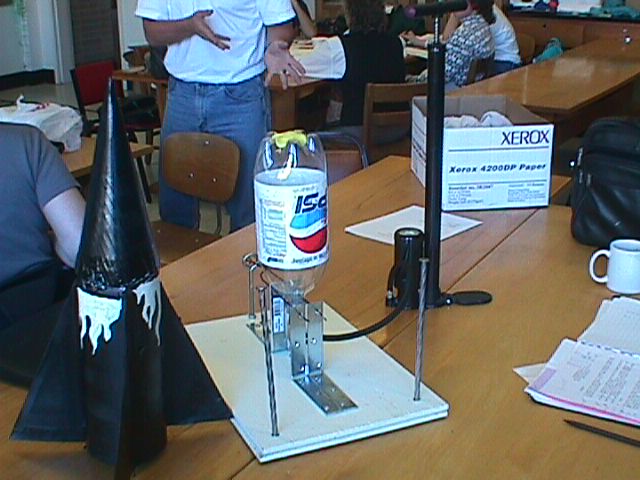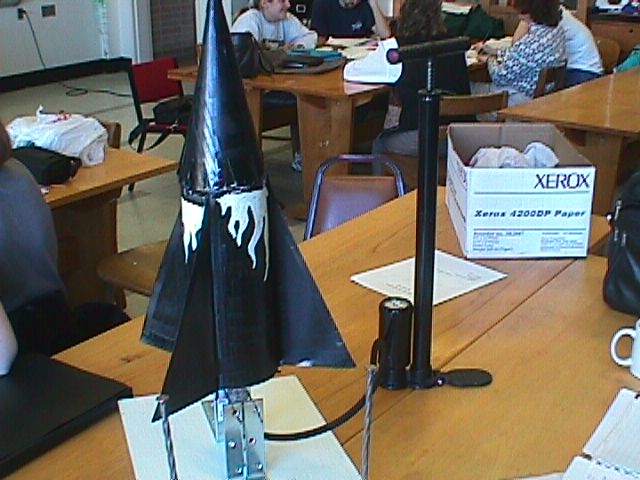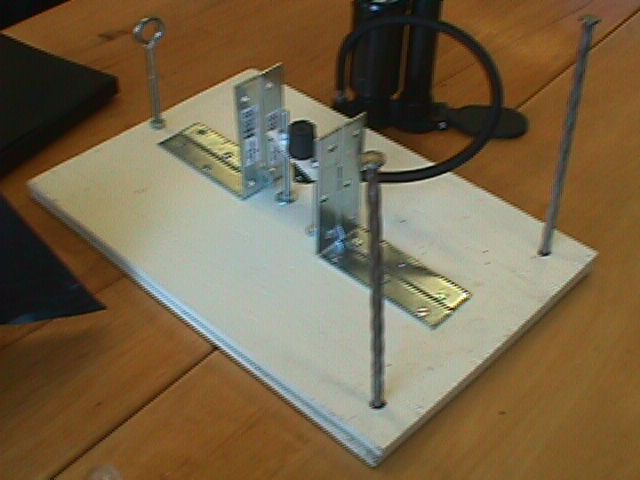|
(Before you begin, print out a worksheet
to use as you complete the activity.)
During the completion of this activity, you will demonstrate science
processing skills, an ability to use technological design, and an
ability to identify factors that affect motion and forces.
Bottle rockets are excellent devices for investigating
"Newton's Three Laws of Motion":
1st Law - A rocket will remain on the launch pad
until an unbalanced force is exerted, propelling the rocket upward.
2nd Law - The amount of force depends
upon how much air is pumped inside the rocket. You can increase
the force further by adding a small amount of water, which increases
the mass expelled by the air pressure in the rocket .
3rd Law - Finally, the action force
of the air (and water) as it rushes out of the nozzle creates an
equal and opposite reaction force propelling the rocket upward.
As with a balloon, air pressurizes the bottle rocket.
Adding a small amount of water to the bottle increases the action
force. The water expels from the bottle before the air does, turning
the bottle rocket into a bigger version of a water rocket toy (available
in toy stores).
Extension Activity: In order
to learn more about model rockets and how they work, follow these
links to information on Flight
of a Model Rocket, Parts
of a Model Rocket, and Forces
on a Model Rocket.
- You will work in teams to construct two water bottle rockets
with empty 2-liter soda bottles. You and your team members must
decide (1) on the design you will use as a result of experimenting
with WaterRocketSim and (2) on the materials you will use for
the body, fins, and cone of the rocket (which is placed over the
empty 2-liter soda bottle before launch). You will then predict
how well your rocket will fly and record your prediction on the
worksheet.
You may want to customize your rockets by decorating them in some
way. An example is shown below:

- One bottle rocket launcher (which can be constructed
according to the instructions shown below or bought from a science
supply catalog) is needed for the class. While one team launches
their rocket, another team can assist them by tracking the rocket,
determining how high it flew, and recording the information on
a worksheet.
(Follow this link to learn how to measure the altitude reached
by your rockets:
Model Rockets, Measured Altitude.) Then compare your prediction
with the rocket's actual performance and compare the flight of
your rocket with other rockets. Your final assignment will be
a journal entry via email giving details on your design, the comparisons
you made, and your conclusions on the reasons for the rockets'
performances.
-
It is important to follow safety rules when
launching bottle rockets. Countdowns help everybody to know
when the rocket will lift off. Using the launch safety instructions
shown below, develop specific launch safety rules through group
discussions. In the rules, include how far back observers should
stand, how many people should prepare the rocket for launch,
and who should retrieve the rocket.

- Select a grassy field that measures approximately 30 meters
in width. Place the launcher in the center of the field and anchor
it in place with the spikes or tent stakes. (If it is a windy
day, place the launcher closer to the side of the field from which
the wind is blowing so that the rocket will drift onto the field
as it descends.)
- As you set up your rocket on the launch pad, observers should
stand back several meters. It is recommended that you rope off
the launch site.
- The team member responsible for pumping air into the rocket
should wear eye protection. The bottle rocket should be pumped
no higher than about 50 pounds of pressure per square inch.
- When pressurization is complete, everyone should stand in back
of the rope for the countdown.
- Continue to countdown and launch the rocket only when the recovery
range is clear.
- A team member should retrieve the rocket.
The launcher is simple and inexpensive to construct. Most needed
parts are available from hardware stores. In addition you will need
a tire valve from an auto parts store and a rubber bottle stopper
from a school science experiment. The most difficult task is to
drill a 3/8-inch hole in the mending plate. An electric drill is
a common household tool. If you do not have access to a drill or
do not wish to drill the holes in the metal mending plate, find
someone who can do the job for you. Ask a teacher or student in
your school's industrial arts shop or the parent of a student to
help.
Materials Needed
· 4 5-inch corner irons with 12 3/4-inch
wood screws to fit
· 1 5-inch mounting plate
· 2 6-inch spikes
· 2 10-inch spikes or metal tent stakes
· 2 5-inch by 1/4-inch carriage bolts with 6 1/4-inch nuts
· 1 3-inch eyebolt with 2 nuts and washers
· 4 3/4-inch diameter washers to fit bolts
· 1 #3 rubber stopper with a single hole
· 1 Snap-in Tubeless Tire valve (small 0.453 inch hole, 2
inches long)
· Wood board 12 x 18 x 3/4 inches
· 1 2-liter plastic bottle
· Electric drill and bits including a 3/8-inch bit
· Screw driver
· Pliers or open-end wrench to fit nuts
· Vice
· 12 feet of 1/4-inch cord
· Pencil

Construction of the Launcher
- Prepare the rubber stopper by enlarging the hole with a drill.
Grip the stopper lightly with a vice and gently enlarge the hole
with a 3/8 inch bit and electric drill. The rubber will stretch
during cutting, making the finished hole somewhat less than 3/8
inches.
- Remove the stopper from the vice and push the needle valve end
of the tire stem through the stopper from the narrow end to the
wide end.
- Prepare the mounting plate by drilling a 1-3/8 inch hole through
the center of the plate. (As safety precautions, hold the
plate with a vice during drilling and wear eye protection.)
Using a drill bit slightly larger than the holes, enlarge
the holes at the opposite ends of the plates. The holes must be
large enough to pass the carriage bolts through them.
- Lay the mending plate in the center of the wood base and mark
the centers of the two outside holes that you enlarged. Drill
holes through the wood big enough to pass the carriage bolts through.
- Push and twist the tire stem into the hole you drilled in the
center of the mounting plate. The fat end of the stopper should
rest on the plate.
- Insert the carriage bolts through the wood base from the bottom
up. Place a hex nut over each bolt and tighten the nut so that
the bolt head pulls into the wood.
- Screw a second nut over each bolt and spin it about halfway
down the bolt. Place a washer over each nut and slip the mounting
plate over the two bolts.
- Press the neck of a 2-liter plastic bottle over the stopper.
You will be using the bottle's wide-neck lip for measuring in
the next step.
- Set up two corner irons so that they look like bookends. Insert
a spike through the top hole of each iron. Slide the irons near
the bottleneck so that the spike rests immediately above the wide
neck lip. The spike will hold the bottle in place while you pump
up the rocket. If the bottle is too low, adjust the nuts beneath
the mounting plate on both sides to raise it.
- Set up the other two corner irons as you did in the previous
step. Place them on the opposite side of the bottle. When you
have the irons aligned so that the spikes rest above and hold
the bottle lip, mark the centers of the holes on the wood base.
(For more precise screwing, drill small pilot holes for each
screw and then screw the corner irons tightly to the base.)
- Install an eyebolt to the edge of the opposite holes for the
hold-down spikes. Drill a hole and hold the bolt in place with
washers and nuts on top and bottom.
- Attach the launch "pull cord" to the head end of
each spike. Run the cord through the eyebolt.
- Make final adjustments to the launcher by attaching the pump
to the tire stem and pumping up the bottle. Refer to the launching
instructions for safety notes. If the air seeps out around the
stopper, the stopper is too loose. Use a pair of pliers or a wrench
to raise each side of the mounting plate in turn to press the
stopper with slightly more force to the bottleneck. When satisfied
with the position, thread the remaining hex nuts over the mounting
plate and tighten them to hold the plate in position.
- Drill two holes through the wood base along one side. The holes
should be large enough to accommodate large spikes (metal tent
stakes). When the launch pad is set up on a grassy field, the
stakes will hold the launcher in place as you yank the pull cord
to launch the rocket.
- The launcher is now complete.
Rubrics:
Use the rubrics shown below as a guide when completing
the activity.
Rubric for constructing the
bottle rocket and recording observations
(30 points max.)
| |
Yes |
No |
| Team carries out assignment criteria |
3 points |
0 points |
| Team performs testing safely |
1 point |
0 points |
| Records observations and findings are correct |
3 points |
0 points |
| Team demonstrates proper science process skills |
3 points |
0 points |
| Participates in class discussions |
5 points |
0 points |
| Team kept on task |
5 points |
0 points |
| Bottle rockets fins aligned properly |
3 points |
0 points |
| Nose cone straight on rocket |
3 points |
0 points |
| Team contributes ideas to the class |
4 points |
0 points |
Rubric for email writing (Worksheet
Question 13)
(12 points max.)
| |
Yes |
No |
| Carries out assignment criteria |
3 points |
0 points |
| Records observations and findings are correct |
3 points |
0 points |
| Demonstrates proper science process skills |
3 points |
0 points |
| Spelling, grammar, and punctuation correct |
3 points |
0 points |
Alternative Recommended Assessments:
- Evaluate each bottle rocket on its quality of construction.
Observe how well the fins align and attach to the bottle. Also
observe the alignment of the nose cone at the top of the rocket.
- Evaluate the design and quality of construction of each bottle
rocket by measuring and comparing the altitudes that the rockets
reached.
Back to top
Close
Window
Any comments, concerns, or questions should be addressed
to: |
Developer: David
Mazza
Responsible NASA Official: Jo Ann Charleston
|
|